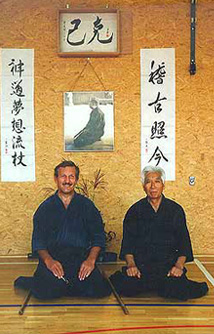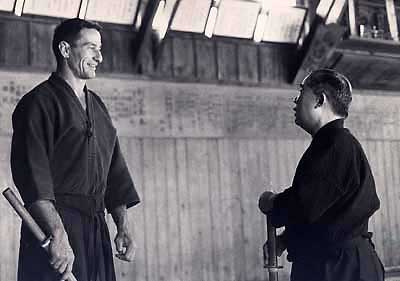
| HOME | JODO | DOJO & CLASSES | TEACHER | EJF | GALERY | DOCUMENTS | LINKS | SEMINARS | CONTACT |

|
- Home page - Shinto Musô Ryû Jodo - The E. F. J. |
|
European Jodo Federation |
|
|
When Shimizu Sensei passed away in 1978, the International Jôdô Federation which he had founded with Donn F. Draeger Sensei became isolated. As the situation in Japan was quite unclear due to the fact that Shimizu Sensei had not named any successor, and that the generation of teachers trained by the latter could not reach any global agreement, each one pursuing his own way, without any concertation and even, in some cases, with rivalship, IJF was not very eager to establish contact with the Japanese Jôdô world. The choice of a particular Teacher was difficult and would have encouraged more rivalship. Draeger Sensei, in charge of the IJF with Quintin Chambers Sensei and Phil Relnick Sensei, decided to stay away from the Japanese scene.
Donn Draeger's charism and integrity were sufficient to give IJF a very solid and credible image. Unhappily, he left us in 1982, victim of a fatal cancer. From then on, the five responsible persons of the IFJ (Quintin T. Chambers, Hawaii, President of the Technical Board, Phil Relnick, USA, President of IJF, Pascal Krieger, Europe, Senior Vice-President, Karunakaran, South-East Asia, Second Vice-President, and Paul Maloney, Australia, Secretary) continued Donn F. Draeger Sensei's work as well as they could. Due to the lack of technical maturity and to the absence of a sole leader, the situation threatened to worsen.  Draeger Sensei listening to his Teacher, Shimizu Sensei (early 1960s) It is in this context that Nishioka Sensei, with whom Phil Relnick had a close relationship, started to help the IJF. Invited by Phil Relnick for the 6th International Jôdô Gasshuku in Hawaii, in 1994, as Technical Advisor, Nishioka Sensei was entusiastically welcomed by the majority of the IJF members. One of the first students of Shimizu Sensei, Nishioka Sensei knows about aspects of Shimizu Sensei’s teaching that we are unaware of. The role of Uchidachi (sword side) recovered all its meaning. For the Shidachi side, a more sideway position was adopted. More accent on Ma-ai (distance) and Ri-ai (logic, timing) gave to his style a coherence that many of the IJF old timers were unconsciously looking for. Encouraged by our enthusiasm, Nishioka Sensei, in the following years, continued to help IJF with all his energy and generosity. He spent several months in Europe (1995, 1996, 1998), in Australia, in Malaysia and in the United States, trying to help everyone. Nishioka Sensei had trained 8 students in Japan to become Menkyo Kaiden. His last two Menkyo Kaiden were given to Phil Relnick and Pascal Krieger. For IJF, this was a new start. More legitimate, more self-confident, the Federation saw its membership grow at an amazing rate. New regions are waiting to become members, mainly in South America where Nishioka Sensei did all the ground work. Far from trying to become a decisive part in the IJF organization, Nishioka Sensei is very strict as far as his position is concerned: he gives technical advices only, but does not want to have anything to do with the administrative matters. Finally, we must note that Nishioka Sensei has given lots of his energy to the IJF during these last ten years without the slightest financial compensation, paying for most of his travel expenses and teaching free. The IJF is extremely grateful to him for this and will continue to do everything possible to give him reasons to be proud of his foreign students. D'après "Fédération Internationale de Jodo"
Voir le site internet de la Fédération Européenne de Jodo
|
Jodo Club Côte-d'Azur - Association loi 1901 à but non lucratif